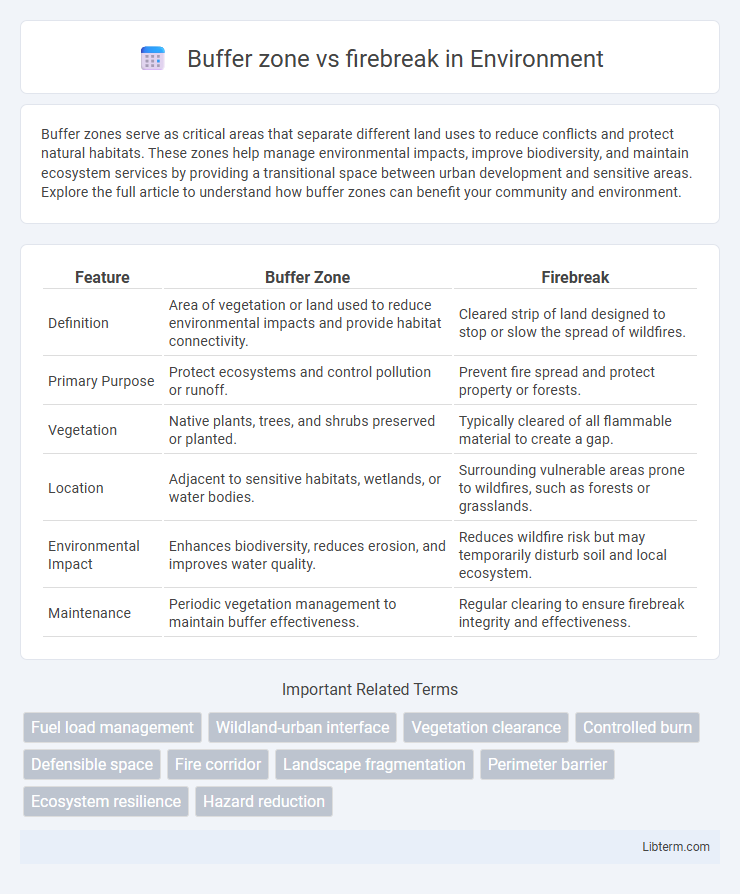Buffer zones serve as critical areas that separate different land uses to reduce conflicts and protect natural habitats. These zones help manage environmental impacts, improve biodiversity, and maintain ecosystem services by providing a transitional space between urban development and sensitive areas. Explore the full article to understand how buffer zones can benefit your community and environment.
Table of Comparison
| Feature | Buffer Zone | Firebreak |
|---|---|---|
| Definition | Area of vegetation or land used to reduce environmental impacts and provide habitat connectivity. | Cleared strip of land designed to stop or slow the spread of wildfires. |
| Primary Purpose | Protect ecosystems and control pollution or runoff. | Prevent fire spread and protect property or forests. |
| Vegetation | Native plants, trees, and shrubs preserved or planted. | Typically cleared of all flammable material to create a gap. |
| Location | Adjacent to sensitive habitats, wetlands, or water bodies. | Surrounding vulnerable areas prone to wildfires, such as forests or grasslands. |
| Environmental Impact | Enhances biodiversity, reduces erosion, and improves water quality. | Reduces wildfire risk but may temporarily disturb soil and local ecosystem. |
| Maintenance | Periodic vegetation management to maintain buffer effectiveness. | Regular clearing to ensure firebreak integrity and effectiveness. |
Definition of Buffer Zone
A buffer zone is a designated area separating two different land uses or ecosystems to reduce the impact of one on the other, often used to protect natural habitats or reduce human-wildlife conflicts. Unlike a firebreak, which is a cleared strip of land designed specifically to stop or slow the spread of wildfire, a buffer zone provides a broader protective barrier that can moderate environmental effects such as noise, pollution, or fire risk. Effective buffer zones typically include vegetation buffers, open spaces, or physical barriers strategically placed to maintain ecological balance and enhance safety.
Definition of Firebreak
A firebreak is a physical gap or cleared strip of land specifically designed to stop the spread of wildfires by removing vegetation and other flammable materials. Unlike a buffer zone, which serves as a broader protective area to reduce fire intensity and provide safety, a firebreak acts as a direct barrier to fire progression. Firebreaks are strategically placed, often in forest management, to interrupt the continuity of combustible fuel for effective wildfire containment.
Key Differences Between Buffer Zones and Firebreaks
Buffer zones are strategically managed areas designed to reduce the intensity of wildfires by slowing their spread and protecting assets through vegetation management, while firebreaks are clear, vegetation-free strips that act as physical barriers to stop or redirect fire progression. The key difference lies in their purpose and design: buffer zones maintain controlled vegetation to mitigate fire impact, whereas firebreaks eliminate combustible material entirely to create an interruption in fuel continuity. Buffer zones often surround critical infrastructure or communities, providing a defensive perimeter, whereas firebreaks are tactical tools used during wildfire suppression to contain active fires or prevent ignition spread.
Purpose and Functionality of Buffer Zones
Buffer zones serve as strategic areas designed to reduce wildfire intensity and protect assets by slowing fire spread and filtering embers, whereas firebreaks are cleared strips of land intended to stop fire directly. The primary functionality of buffer zones involves creating a defensible space with reduced fuel continuity, enhancing the effectiveness of fire suppression efforts. These zones also contribute to ecological stability and minimize environmental impact by maintaining some vegetation cover while controlling fire behavior.
Purpose and Functionality of Firebreaks
Firebreaks serve as physical barriers designed to halt or slow the spread of wildfires by removing combustible materials, creating a clear gap that fire cannot easily cross. These strategic interruptions in vegetation help protect critical infrastructure and natural resources by controlling the fire's path and intensity. Unlike broader buffer zones, firebreaks primarily function as immediate containment lines to manage active fire behavior effectively.
Implementation Techniques for Buffer Zones
Buffer zones are implemented through strategic vegetation management, involving the use of fire-resistant plants and the establishment of multi-layered greenery to slow fire spread and protect critical areas. Techniques include selective thinning, controlled planting, and maintaining moisture-retentive ground cover to reduce fuel availability. These practices create a living barrier that complements firebreaks, which are cleared strips of land designed solely to stop fires by removing combustible material.
Construction Methods for Firebreaks
Firebreak construction methods involve clearing vegetation and combustible materials to create a gap that halts the spread of wildfire by eliminating fuel continuity. Techniques include mechanical clearing with bulldozers or hand tools, controlled burns to remove flammable debris, and the application of fire-retardant materials. Effective firebreaks are strategically placed based on terrain, vegetation type, and fire behavior modeling to maximize their protective function.
Ecological Impact: Buffer Zone vs Firebreak
Buffer zones support biodiversity by preserving native vegetation and providing wildlife habitats, contributing to ecosystem resilience and reducing soil erosion. Firebreaks, while effective in halting fires, often involve clearing vegetation, which can disrupt local ecosystems and reduce habitat connectivity. The ecological impact of buffer zones is generally less disruptive, promoting long-term environmental balance compared to firebreaks' more immediate but intrusive fire control method.
Effectiveness in Wildfire Prevention
Buffer zones reduce wildfire risk by creating defensible space with low flammability vegetation, which slows fire spread and protects structures. Firebreaks are cleared strips that remove all combustible material, providing a physical barrier to halt or redirect wildfires effectively. Combining buffer zones and firebreaks enhances overall wildfire prevention by minimizing fuel availability and interrupting fire pathways.
Best Practices for Buffer Zones and Firebreaks
Best practices for buffer zones include maintaining a wide strip of low-flammability vegetation to reduce wildfire intensity and provide a defense barrier. Firebreaks should be strategically cleared of all combustible materials to create a continuous strip that halts fire spread and facilitates firefighting access. Regular maintenance and monitoring of both buffer zones and firebreaks enhance their effectiveness in wildfire management and landscape protection.
Buffer zone Infographic

 libterm.com
libterm.com